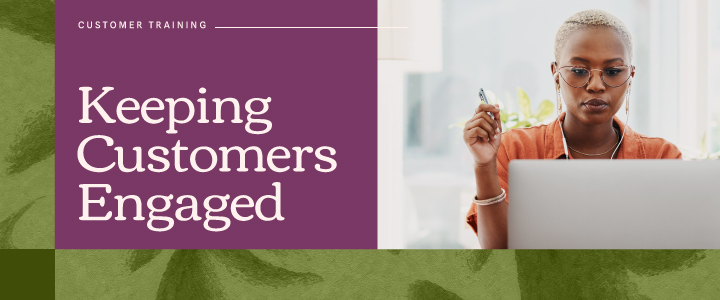
6 min reading time
Competency Frameworks: The L&D Growth Guide’s Most Essential Tool?
What you’ll learn:
For L&D professionals stepping into the role of ‘Growth Guide’, there’s an opportunity to shape meaningful development, guide better conversations, and demonstrate the true value of learning to the business. This is where competency frameworks come in.
In this article, we cover:
- Why unclear expectations push employees to leave
- How effective competency frameworks help, and what they actually look like
- How to build one that works for your organization
At LearnUpon, we talk a lot about how keeping people engaged at work isn’t just about paychecks or perks. It’s about growth. And when employees don’t know how to grow with you, they’ll eventually look for clarity somewhere else.
That’s where competency frameworks come in, and why they’re such an important tool for today’s L&D leaders, stepping into the role of Growth Guides.
As an L&D Growth Guide, your job isn’t just to deliver training or tick compliance boxes. It’s to show people the way forward—making career development visible, structured, and connected to the bigger picture of the business. Competency frameworks help you do exactly that.
They give employees clarity, managers confidence, and businesses a clear link between learning and measurable results.
But what does an effective competency framework look like, and why is it such a powerful tool for retention and growth?
Before we dive into that, let’s consider why they’re needed in the first place…
Why Vague Expectations Drive People to Leave
Turnover rarely begins with a resignation letter. More often, it starts quietly.
For employees who feel like their growth has stalled, the problem isn’t usually the work itself. It’s the uncertainty that creeps in when expectations are vague and progress feels impossible to measure.
In that gap, employees begin to wonder:
- What does “good” actually look like in this role?
- Which skills will really help me move forward?
- What would it take to step into the next opportunity?
When those answers aren’t clear, even hard work can feel like guesswork. Progression starts to feel invisible, motivation fades, and eventually, top performers disengage.
Research backs this up: lack of career development is consistently one of the biggest reasons employees leave. People don’t just want a fair paycheck—they want to feel like they’re building towards something meaningful.
This is where your role as an L&D Growth Guide becomes critical. Employees need more than training; they need guidance, and competency frameworks provide the structure to make that guidance real.
What Is a Competency Framework?
Even seasoned L&D leaders know what a competency framework is: a roadmap that maps out the skills, knowledge, and behaviors that define success in a role. But sometimes, it’s worth revisiting why they matter—especially when the goal is to move from delivering training to guiding careers.
Without a framework, career conversations often stay vague: “Do more” or “Show leadership.” With one in place, they become motivating and actionable: “Here’s the progress you’ve made, here’s what’s next, and here’s how we’ll help you get there.”
That’s the shift from L&D professional to L&D Growth Guide: not just delivering training, but guiding careers.
Think of it this way:
- For employees, it’s direction: Competency frameworks essentially tell employees “Here’s where you are today, here’s where you could go next.” This not only makes growth feel achievable, it builds loyalty by showing a clear future inside your organization.
- For managers, it’s consistency: The right kind of framework can provide a shared language for feedback, development conversations, and fair promotion decisions—helping them build trust, spot potential early, and guide employees with confidence.
- For the business, it’s alignment: A mature, strategic approach to employee development means connecting growth to the capabilities the organization truly relies on. The result? Better performance, stronger retention, and development that actually supports business goals.
How to Build Competency Frameworks That Actually Work
Not every competency framework delivers on its promise. A lot of the time, they end up as static documents—nice on paper but disconnected from real growth.
Even if you already have a framework in place, you can evolve it by tying competencies to business outcomes—making it a living tool that grows alongside your people and strategy.
The frameworks that work? They balance structure with flexibility, reflect the realities of each role, and give employees and managers a practical tool they can return to again and again.
Here’s how to build one with a true L&D Growth Guide mindset:
1. Define competencies in context: Spell out the mix of technical, soft, and leadership skills each role really requires, and show how proficiency evolves over time.
For example: In a customer support role, “problem-solving” might progress from logging recurring issues, to suggesting fixes to the product team, to leading cross-functional projects that improve the customer experience. Defining it this way keeps the competency grounded in real work and tied to measurable outcomes.
2. Keep it practical and accessible: Avoid jargon and ground everything in day-to-day work so employees can pick it up and actually use it.
For example: For a sales role, instead of writing “demonstrates strong communication,” break it into actions like “runs effective discovery calls,” “tailors demos to different buyer personas,” and “negotiates win–win agreements.” Phrasing it this way makes the competency usable in everyday coaching and feedback.
3. Track progression in steps, not leaps: Make development feel achievable by mapping growth in visible stages, not vague leaps.
For example: For a people manager, “coaching skills” could progress from “gives feedback in 1:1s”, to “creates development plans with direct reports,” to “mentors other managers across the business”. Breaking it down like this helps employees see progress in manageable, motivating stages.
4. Link competencies to action: Tie each competency to learning resources, mentoring, or projects so people can actively grow.
For example: If “strategic thinking” is a target competency, connect it to stretch opportunities like leading a pilot initiative, shadowing a senior leader in quarterly planning, or completing a business case workshop. Linking it this way makes growth practical and actionable, not just theoretical.
Tip: When you have the right framework in place, it becomes easier to connect competencies and growth to business priorities—and to report on it. With clearer visibility into how growth leads to outcomes like retention, mobility, and engagement, you can demonstrate real impact to both employees and leadership.
Helping Managers Have Better Conversations
Managers play a huge role in employee growth. But as mentioned, a lack of strategy and structure can lead to career conversations that feel vague or inconsistent.
As an L&D Growth Guide, your job is to support managers with competency frameworks that:
- Bring clarity to check-ins: Progress tied to defined skills and behaviors gives managers a clear foundation for feedback and direction.
- Help spot growth opportunities early: The right frameworks highlight when an employee is ready for more responsibility, lateral moves, or leadership preparation.
- Make feedback feel fair: Visible and consistent expectations ensure employees trust that growth is measured objectively, not subjectively.
This shifts conversations from being “once-a-year” reviews to genuine coaching moments employees actually value.
Can Competency Frameworks Really Fuel Retention & Long-Term Growth?
Competency frameworks aren’t just about mapping skills. They’re about making growth visible in a way that keeps people engaged and committed long-term.
In our State of L&D 2025 report, 36% of leaders said integrating L&D with business strategy is a top priority this year. That tells us something important: the best teams aren’t just running training programs, they’re using learning to move the business forward — and behind every great business are great people.
When employees see how their development links directly to opportunities inside the organization, they’re more likely to stay. When managers have a clear framework to guide conversations, they coach with confidence. And when the business can show how growth ties back to strategy, L&D becomes a proven driver of retention and long-term success.
That’s why competency frameworks matter. They’re not HR checklists. They’re Growth Guide tools—a way to connect learning with opportunity, and opportunity with loyalty.
From Framework to Business Advantage
By mapping what success looks like and tying it directly to learning, everyday roles can become genuine career journeys.
And when employees can clearly see their progress, you don’t just improve retention—you create engagement, loyalty, and long-term business impact.
Ready to see how LearnUpon can help you connect frameworks to real growth? Book a demo or explore our resources to find out more.



